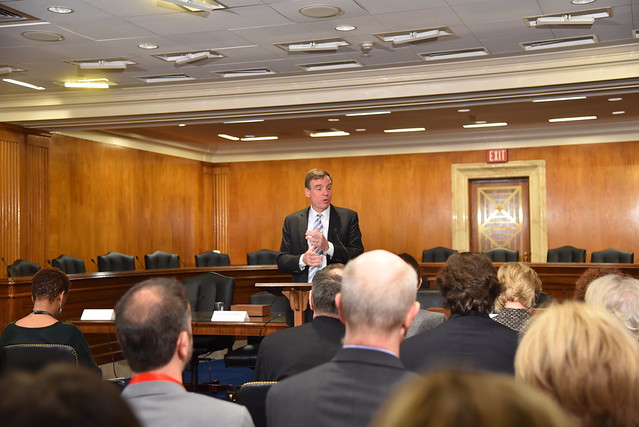Press Releases
Sen. Warner Introduces Bipartisan Bill to Expand Telehealth Services
Bill would expand the use of telehealth and remote patient monitoring through Medicare, expanding access to high-quality healthcare while reducing costs
Feb 03 2016

WASHINGTON – Today, U.S. Sen. Mark R. Warner (D-VA) joined Sens. Roger Wicker (R-MS), Brian Schatz (D-HI), Thad Cochran (R-MS), Ben Cardin (D-MD), and John Thune (R-SD) to unveil the Creating Opportunities Now for Necessary and Effective Care Technologies (CONNECT) for Health Act, bipartisan legislation that would expand telehealth services through Medicare, improve care outcomes, make it easier for patients to connect with their health care providers, and help cut costs for patients and providers. Companion legislation was introduced in the House of Representatives by U.S. Reps. Diane Black (R-TN), Peter Welch (D-VT), and Gregg Harper (R-MS).
“Technology has enormous potential to transform the Medicare program,” said Sen. Warner. “As Governor of Virginia, I saw up close how telehealth improved efficiency, access and outcomes in Medicaid. Moving forward, we should look for more ways to harness innovation and give Medicare providers more tools for delivering care. This bipartisan bill provides a strong starting point, building on the progress we’ve already made in Virginia, and includes strong quality metrics to give us a better sense of what works and what doesn’t as our healthcare system moves further into the 21st century.”
Telehealth is the provision of health care services via telecommunications technologies, such as live video interactions. Remote patient monitoring refers to personal medical data transmitted securely from an individual in one location via electronic communications technologies to a provider in a different location for the purposes of medical care.
In 2003, then-Gov. Warner expanded Medicaid coverage for telemedicine statewide, including evaluation and management visits, a range of individual psychotherapies, the full range of consultations, and some clinical services, including in cardiology and obstetrics. Coverage was also expanded to include non-physician providers. Among other benefits, the telehealth expansion allowed individuals in medically underserved and remote areas of Virginia to access quality specialty care that isn’t always available at home.
Virginia is a national leader in telemedicine. The University of Virginia Center for Telehealth was launched in 1994 and has since grown into a national model for the health industry. Since then, UVA and its network of 152 telemedicine partners have enabled more than 51,000 patient encounters across more than 60 specialties, saving Virginians roughly 16 million miles of travel. The Center’s Telehealth care coordination and remote patient monitoring program, a partnership with Charlottesville-based Locus Health, has reduced hospital readmissions by more than 40 percent.
While the center was selected as one of 14 regional telehealth resource centers by the federal government, it still faces barriers to delivering care because outdated federal laws restricts Medicare’s coverage of telehealth services.
“The University of Virginia Health System and our Center for Telehealth are thrilled to work with Senator Warner to reduce barriers to the adoption of telehealth and remote patient monitoring to further improve access to timely, high quality care for our Medicare beneficiaries,” said Dr. Karen Rheuban, Director of the UVA Center for Telehealth, who was in Washington today for the bill’s introduction. “The Connect for Health Act promises to modernize our Medicare program and align 21st century healthcare policies with 21st century innovations in telehealth.”
According to studies, telehealth and remote patient monitoring have both been shown to improve care and patient satisfaction while reducing hospitalizations. The CONNECT for Health Act is a bipartisan approach to increase the use of telehealth and remote patient monitoring through Medicare. Specifically, the legislation would:
- Create a program to help providers meet the goals of the Medicare Access and CHIP Reauthorization Act and the Merit-based Incentive Payment System through the use of telehealth and remote patient monitoring (RPM);
- Expand the use of RPM for certain patients with chronic conditions;
- Increase telehealth and RPM services in community health centers and rural health clinics; and
- Make telehealth and RPM basic benefits in Medicare Advantage.
“The AMA is pleased to support legislation that would accelerate the adoption of health care delivery models that promote coordinated and patient-centered care,” said Steven J. Stack, M.D., President of the American Medical Association. “This bill would ensure that patients and their physicians are able to use new technologies that remove barriers to timely quality care. Importantly, the bill would maintain high standards whether a patient is seeing a physician in an office or via telemedicine. We look forward to working with other supporters to advance this legislation in Congress.”
“The time, thought and coordination that went into drafting this bill shows,” said Krista Drobac, Executive Director of the Alliance for Connected Care. “It is a consensus-based approach with support from groups across the spectrum. It will result in meaningful change.”
The CONNECT for Health Act is supported more than 50 organizations including AARP, ACT | The App Association, Alliance for Connected Care, America’s Essential Hospitals, America’s Health Insurance Plans, American Heart Association/American Stroke Association, American Medical Association, American Society of Nephrology, American Telemedicine Association, American Well, Anthem, Association for Behavioral Health and Wellness, The ERISA Industry Committee, Hawaii Medical Service Association, Healthcare Leadership Council, HIMSS, Intel, Kaiser Permanente, National Association of Community Health Centers, Personal Connected Health Alliance, Qualcomm, Third Way, University of Mississippi Medical Center’s Center for Telehealth, and the University of Virginia Center for Telehealth.
The full bill text is available here.